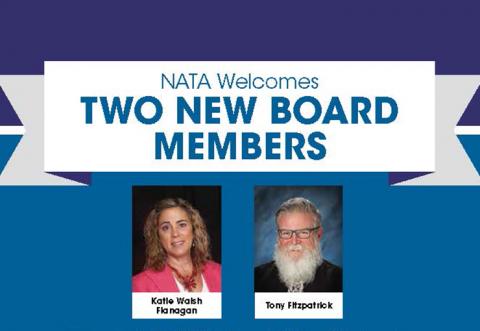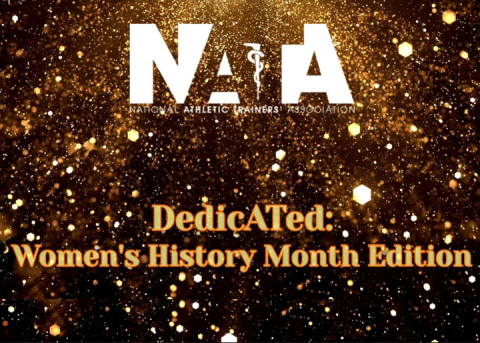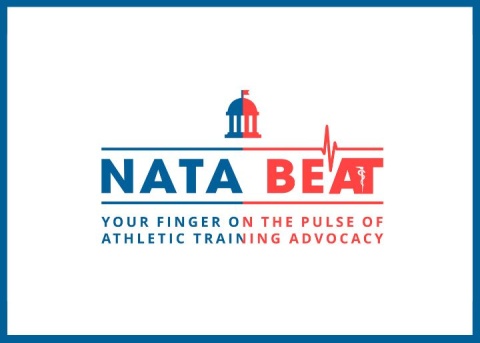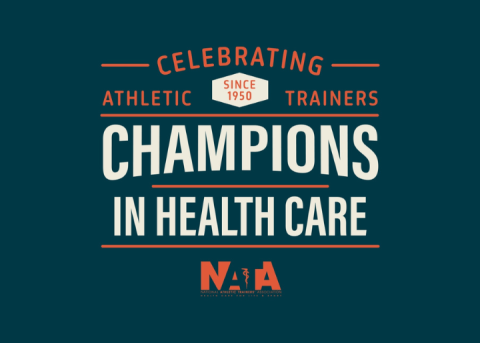
The July NATA News featured an article about new NATA board members Katie Walsh Flanagan, EdD, ATC, LAT, representing District Three, and Tony Fitzpatrick, MA, ATC, LAT, representing District Ten. In it, they discussed why they wanted to serve on the NATA Board of Directors, why volunteerism is important to them and what drew them to the athletic training profession.
“I truly love being a part of something much bigger than any one person, and the NATA Board of Directors absolutely fits that description,” Flanagan said. “It is this blending of ideas and strengths that makes the NATA the strong organization that it is, and I cannot wait to be on board.”
“Finding a way to be involved at any level—local, state, district or national—has made me a better athletic trainer,” Fitzpatrick said. “Volunteering and involvement helped me to see past myself to what is important for the strength of our profession and the health of our association.”
Continue reading to learn more about your new NATA directors.
What do you hope to accomplish during your time on the NATA Board of Directors?
KWF: As a program director, researcher and athletic trainer, I have a unique vantage point, which I bring to the board. Together, and under great leadership, we will move forward the work of our past directors to advocate for the profession of athletic training. We will continue our efforts nationally to recognize the athletic trainer as the go-to health care provider in a wide variety of settings. Additionally, in conjunction with our strategic alliance partners, we need to work together with the membership to make the transitions in our educational programming as seamless as possible.
TF: Besides being prepared to discuss issues and initiatives, I hope to be a part of this amazing collective of professionals from all settings to help move our profession and association forward. I know that this sounds stereotypical, but I have no set platform or agenda to bring to the board. I’m coming in with an open mind and a clean slate, so to speak, ready to roll my sleeve up, go to work and to move our association forward. I think that is what members expect.
What has been your most memorable moment in the profession so far?
KWF: Standing on the playing field and hearing the “The Star-Spangles Banner” before events, especially in foreign countries. I think all Americans stand a little taller, and I’m so thankful to be involved as a health care provider, where I get to still be with a team and part of something in which I believe.
TF: Perhaps the most memorable moment was the first time my parents visited me from Montana, for a football game when I was the head athletic trainer for Boise High School. They came to watch me work. It was the first time they saw me, on my “own” as an athletic trainer, doing what I loved. As sentimental as it sounds, there is something special when your parents come to watch you work and the look of pride in their faces afterwards.
Who has influenced and mentored you in your career?
KWF: My very first exposure to this field came from Bill (Ropes) Robertson (Oregon State University); and since then others have shaped my path: Paul Schechter (Fresno State University), Jill Walker Dale, Sally Perkins, Gretchen Schlabach, Katie Grove, Chris Ingersoll, Rich Ray, Paula Turocy, Bill Prentice and so many more. All, in their own way, made things happen, volunteered a lot, made a difference, moved the profession forward, had fun and just made it all look so easy.
TF: There have been two men who have had a great influence on me and have mentored me these past 29 years: NATA Hall of Famers Gary Craner and Tom Koto. Both of these men served the NWATA in many ways including as district director and president.
Craner was my mentor at Boise State University when I was his graduate assistant. His excitement and passion for NATA really took hold in me right from the start. He made me see the connection between being a member of the NATA and the profession of athletic training. His passion and love for our association was infectious and I wanted to follow in his footsteps.
Koto has been the mentor to smooth out a lot of my rough and sharp edges as a member in service to NATA. He challenged me to look beyond my athletic training facility office, to expand my thinking past the setting I practice in and to not only serve the members of NWATA but to see things more globally in regards to initiatives, issues and how they can have an impact on all athletic trainers, not just a particular setting or niche.
Both men have pushed me with their questions to make me think bigger and not of myself, but for the membership and to always come to the table prepared and with possible solutions, right or wrong, to concerns I may have about something.
What advice would you give to young athletic trainers new to the profession?
KWF: Be completely present in all you do. Show up at every practice/event and learning opportunity as engaged and open as you can be. You will be amazed on how much you can learn. Also, do not try to be all things to everyone. Be the best “you” that you can be, and it will all work out. Balance is key, so find something outside of athletic training that is worthwhile and fun that you truly enjoy—then make time for it.
TF:
- Get involved! You may not land that “sweet” or “coveted” committee or workgroup assignment right out of the gate, but contact your local, state, district and national leaders and find out where you can be of assistance and serve. Don’t serve for yourself, serve for others
- Ask questions! Don’t be afraid to ask questions or bring concerns to the table.
- Bring solutions! It’s a hard lesson I’ve learned over 29 years, not to just complain to a principal, an a, a coach, a committee chair or even a district director without coming with possible solutions or answers. They may not be the right or best answer, but at least it’s a starting point.
- Be patient! NATA and the profession of athletic training is not the NATA and athletic training profession I came into in 1988. It is so much richer, different and expansive, but it also has it’s growing pains, too! Any profession and association will as it grows. So don’t expect instant change and don’t be angry if change doesn’t occur at your pace. Get involved to help the change happen, then in 10, 20 or 30 years, you, too, will look back with wonderment at how far both have come
- Be fiercely diligent! Change will not happen without your involvement. So much is happening governmentally at the state and federal levels. As young athletic trainers, as well as “seasoned” athletic trainers, we have to be ready to act when called upon whether it’s making a phone call to a legislator, congressman or senator or writing an email or sending a card. We all have to act in order for the change we want to happen to happen!
- Finally have fun! We are in a professional that is on the cutting edge of so many great things. What an exciting time it is to be an athletic trainer!




